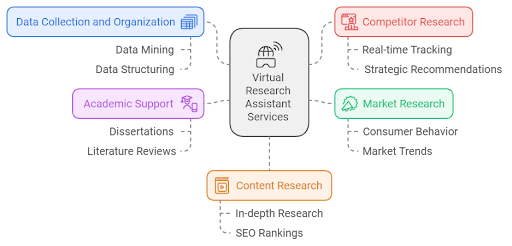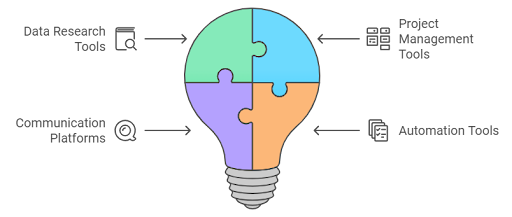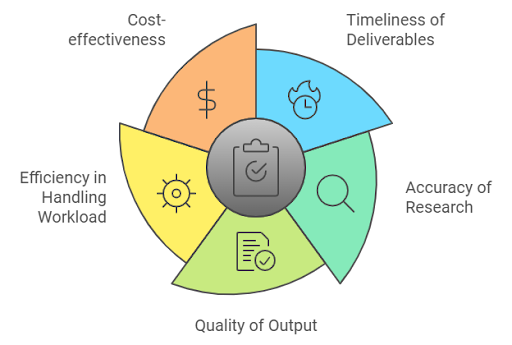
As the digital landscape evolves rapidly, businesses, researchers, and professionals are continuously seeking methods to optimize operations, enhance efficiency, and minimize overhead costs. One solution that’s becoming increasingly popular is the use of virtual research assistants (VRAs). These professionals help businesses, researchers, and individuals complete research tasks remotely, offering flexibility, specialized skills, and cost savings.
The growing demand for outsourcing research services has led to a surge in the popularity of VRAs. This comprehensive guide will walk you through everything you need to know about utilizing a virtual research assistant—from what they do to how they can benefit your business. Additionally, we will introduce Avery Outsourcing, a leader in providing virtual assistant services in Singapore, and how they can help take your business to the next level.
What is a Virtual Research Assistant?
A virtual research assistant is a remote professional who performs research-related tasks such as data collection, market analysis, and report generation. Unlike traditional in-house assistants, VRAs offer businesses and individuals the flexibility to hire based on specific project needs, whether short-term or ongoing.
VRAs have become essential for industries that require constant data flow, such as marketing, business development, academia, and more. Because they work remotely, companies can tap into a global talent pool, allowing them to find experts with specialized knowledge without being confined by geography.
Core Responsibilities of Virtual Research Assistants
While the exact tasks of a VRA may vary based on industry and business needs, here’s a closer look at the core responsibilities:
- Data Collection: Gathering and synthesizing data from credible sources such as academic journals, market reports, and government databases.
- Competitor Analysis: Keeping track of competitors’ products, services, and strategies to help businesses stay ahead in their industry.
- Market Research: VRAs provide businesses with actionable insights on customer preferences, market trends, and potential growth opportunities.
- Report Writing: Compiling research data into structured reports that are easy to read and understand.
- Academic Assistance: Helping students, professors, and researchers by gathering resources, reviewing academic papers, and providing citation support.
Industries That Benefit the Most from VRAs
- Marketing Agencies: Constant competitor analysis and data collection on consumer behavior are vital to the success of marketing campaigns. VRAs can keep agencies informed on emerging trends.
- Startups and Small Businesses: These organizations often face resource constraints. Outsourcing research tasks to a VRA ensures that they get the insights they need without the costs associated with hiring full-time staff.
- Academic Institutions: From conducting literature reviews to assisting in grant applications, VRAs are invaluable for universities and research institutions.
- E-commerce Businesses: Virtual research assistants can help online retailers track competitors, analyze consumer buying behavior, and find untapped markets.
The Benefits of Using a Virtual Research Assistant
Hiring a virtual research assistant comes with a wide array of benefits, making it an increasingly popular option for businesses of all sizes. Here’s a deeper dive into the advantages:
1. Cost Efficiency
In a business climate where every penny counts, the cost-saving potential of a VRA cannot be overstated. Rather than bearing the financial burden of hiring a full-time employee (which includes salary, benefits, and office overhead), businesses can hire VRAs on a per-project basis. This flexible arrangement ensures businesses only pay for the services they need. In fact, according to a recent study, outsourcing tasks such as research can reduce business operational costs by up to 70%.
Furthermore, hiring a virtual research assistant allows businesses to avoid investing in expensive research tools or software, as most VRAs bring their own resources.
2. Time Savings
Delegating research tasks to a professional allows business owners and key team members to focus on core tasks that drive growth. For example, instead of spending countless hours gathering data for a new product launch, a CEO can focus on developing partnerships or securing funding while the VRA provides the necessary research.
A well-managed VRA can also fast-track projects that would otherwise take significantly longer. Many businesses report a noticeable boost in productivity after outsourcing repetitive or time-consuming tasks to a skilled virtual assistant.
3. Access to Expertise
Virtual research assistants often specialize in niche fields, allowing businesses to gain access to a higher level of expertise than might be available through in-house hires. For example, a VRA with experience in financial market analysis can provide deeper insights for investment firms than a generalist employee. Similarly, startups entering a new market can benefit from a VRA with local market expertise.
Moreover, many VRAs stay up-to-date on industry-specific tools, software, and methodologies, ensuring that their clients always receive high-quality, data-backed results.
4. Scalability and Flexibility
The virtual research assistant model is inherently scalable. Businesses can hire a VRA for a one-time project or long-term engagement, depending on their needs. As your business grows, you can easily increase the number of hours or hire additional VRAs to manage larger research projects.
The flexibility VRAs offer is particularly beneficial for seasonal businesses or startups that experience fluctuating workloads. You can scale your research capacity up or down based on real-time needs without the long-term commitment or legal complexities of hiring full-time staff.
5. Global Reach and 24/7 Availability
Another key advantage of hiring a VRA is the ability to work with professionals in different time zones. For instance, businesses in the United States can hire VRAs from Asia or Europe to work on research tasks overnight. This creates an around-the-clock workflow that keeps research projects moving, even while your team is offline.
Global VRAs also bring local market insights that can be invaluable for businesses looking to expand internationally.
Key Tasks and Services Provided by a Virtual Research Assistant

In addition to basic research tasks, VRAs are often equipped to handle more specialized services. Below are some of the key tasks and services provided by virtual research assistants:
Data Collection and Organization
One of the most fundamental roles of a VRA is to gather and structure data. Whether it’s mining data from public records or compiling internal business data into a digestible format, VRAs are well-versed in sourcing credible information efficiently. For example, a retail company looking to expand its product line could hire a VRA to conduct a competitor analysis and provide data on pricing, product availability, and customer reviews.
Competitor Research
Competitor research is critical for businesses looking to stay ahead. A VRA can track competitors’ moves in real-time, analyze their product offerings, and provide strategic recommendations based on competitors’ strengths and weaknesses. This service is especially valuable in highly competitive industries like tech and e-commerce, where staying ahead of the competition can mean the difference between success and failure.
Market Research
Market research forms the backbone of strategic decision-making for businesses looking to expand into new territories or launch new products. A virtual research assistant can provide comprehensive market research reports that include data on consumer behavior, market trends, and industry forecasts. For example, a beauty brand expanding into Southeast Asia could leverage a VRA to analyze local buying patterns and customer preferences.
Academic Support
VRAs with academic research backgrounds are frequently hired to assist with dissertations, literature reviews, and even data analysis for academic papers. Professors and students alike rely on VRAs to gather resources, analyze data, and ensure that research is presented in an organized, methodologically sound manner.
Content Research
Marketers and content creators often use VRAs to assist in content development by providing in-depth research, statistics, and trends that back up their articles, blog posts, or whitepapers. A well-researched piece of content not only builds credibility but also boosts SEO rankings by offering valuable insights that readers seek.
How to Effectively Utilize a Virtual Research Assistant
While virtual research assistants offer a plethora of benefits, their effectiveness depends largely on how they are managed. Below are some best practices for maximizing the value of your VRA:
Clear Communication
The foundation of any successful outsourcing relationship is communication. When working with a VRA, it’s important to set clear expectations from the outset. This includes defining the scope of the project, outlining deadlines, and communicating the desired format of the research deliverables. VRAs appreciate clear and precise instructions, as it helps them tailor their work to meet your needs.
Defining Project Scope
Clearly defining the project scope ensures that both you and your VRA understand the goals and deliverables. A detailed project brief might include:
- The key research questions
- Desired data sources
- The format in which the data should be presented
- Timeline and milestones for project completion
By providing these details upfront, you can avoid misunderstandings and ensure that your VRA focuses on what’s most important.
Regular Check-ins and Progress Updates
Even though VRAs work independently, regular communication is crucial for tracking progress. Schedule regular check-ins to discuss the status of the project, provide feedback, and address any concerns. Tools like Slack, Zoom, and Asana can help facilitate smooth communication and project tracking.
Providing Constructive Feedback
Constructive feedback is essential for improving the quality of your VRA’s work. If a report or research document doesn’t meet your expectations, provide specific feedback on how it can be improved. This not only helps your VRA deliver better results in the future but also fosters a strong working relationship.
Using Collaboration Tools
Make use of project management and collaboration tools like Trello, Asana, or Monday.com to track the progress of research tasks. These tools can help both you and your VRA stay organized and meet deadlines efficiently.
The Role of Virtual Research Assistants in Remote Work
Adaptability in Remote Environments
One of the key reasons virtual research assistants (VRAs) have become indispensable in today’s remote-first world is their ability to seamlessly adapt to a variety of working environments. With businesses embracing remote and hybrid models, VRAs offer an unmatched level of flexibility, allowing companies to maintain productivity even when their internal teams are distributed across different locations.
VRAs are accustomed to using remote communication tools and project management systems to stay connected with their clients and deliver results efficiently. The adaptability of VRAs goes beyond just tools and processes—they are also skilled in navigating cultural differences, managing varying client expectations, and ensuring that time zone disparities do not disrupt the flow of work.
Cost Benefits in Remote Work Models
The shift towards remote work has also brought cost advantages. Hiring a full-time research assistant with the accompanying overheads such as office space, equipment, and employee benefits is a significant investment. In contrast, VRAs operate remotely, eliminating the need for these additional expenses. Businesses are now able to allocate these saved resources toward other critical areas such as marketing, product development, or expanding into new markets.
Seamless Integration with Remote Teams
Contrary to some misconceptions, integrating a virtual research assistant into a remote team is usually a smooth process. Thanks to cloud-based tools such as Google Drive, Dropbox, and Microsoft Teams, VRAs can easily share documents, collaborate on research projects, and contribute to team discussions. This integration enables businesses to utilize the expertise of VRAs without needing them to be physically present.
To ensure smooth collaboration, many companies create a dedicated communication protocol for remote workers, allowing VRAs to engage with key team members and provide updates without disrupting the normal workflow.
Collaborating Across Time Zones
One of the primary advantages of hiring a virtual research assistant from a different time zone is the ability to maintain continuous workflow. For example, if your business operates in New York and your VRA is based in Singapore, research tasks can be completed during your off-hours, providing you with results as soon as the next business day begins.
However, successful time-zone collaboration requires clear expectations around availability and deadlines. Scheduling tools such as World Time Buddy and Google Calendar allow you to plan meetings and set deadlines that accommodate the working hours of both your in-house team and your VRA. By clearly establishing communication windows and ensuring overlapping hours when necessary, businesses can maintain effective collaboration, even across continents.
Top Tools for Virtual Research Assistants

The efficiency and success of a virtual research assistant largely depend on the tools they use to carry out their tasks. These tools ensure that VRAs can effectively manage tasks, gather accurate data, and collaborate with clients. Here’s a deeper look at some of the most important tools for VRAs:
1. Data Research Tools
The core of any VRA’s work lies in collecting and synthesizing information. VRAs rely on a variety of data research tools to ensure they gather credible, up-to-date data that is relevant to their client’s needs.
- Google Scholar: Google Scholar is one of the most widely used platforms for finding academic papers and peer-reviewed articles. VRAs can use this tool to gather scientific research, historical data, and authoritative sources for in-depth research projects.
- Statista: Statista is a great source for comprehensive data and statistics across multiple industries. VRAs can leverage Statista’s extensive collection of market research data to analyze trends, provide forecasts, and compare industry benchmarks.
- Pew Research Center: Pew is particularly useful for social research, providing high-quality reports on demographics, public opinion, and social trends. This makes it invaluable for VRAs involved in social science research or consumer behavior analysis.
2. Project Management Tools
Project management is key when dealing with virtual teams. Virtual research assistants often use project management tools to stay organized and ensure timely completion of tasks.
- Trello: Trello offers a simple yet powerful way to manage tasks with visual boards. VRAs and clients can use Trello to track research projects, set deadlines, and monitor progress, making it easier to collaborate and stay on the same page.
- Monday.com: For more complex projects, Monday.com provides customizable workflows that allow teams to plan, track, and deliver work efficiently. This is particularly helpful for long-term research projects that require multiple phases of completion.
- Asana: Asana is another top-tier tool that helps VRAs prioritize tasks, meet deadlines, and collaborate with their clients seamlessly. Asana’s integrations with communication tools ensure that there are no gaps in project updates.
3. Communication Platforms
Communication is crucial in the virtual assistant-client relationship, especially when research updates or clarifications are required.
- Slack: Slack is a highly popular tool for real-time communication. VRAs can use Slack channels for specific projects, making it easy to streamline communication with multiple stakeholders without getting lost in lengthy email threads.
- Zoom: Video conferencing remains an essential tool for remote collaboration. VRAs can use Zoom to discuss project details, present findings, or offer progress updates during face-to-face virtual meetings.
- Microsoft Teams: For organizations already using Microsoft Office 365, Microsoft Teams is the ideal communication tool. It combines chat, video conferencing, and document sharing, making it easy for VRAs to collaborate on shared research documents with their clients.
4. Automation Tools
Automation tools can significantly increase the efficiency of a virtual research assistant, particularly when dealing with repetitive tasks or complex workflows.
- Zapier: Zapier allows VRAs to automate tasks by connecting different apps, streamlining workflows, and reducing manual work. For example, if a VRA needs to regularly pull data from one platform and upload it to a different database, Zapier can automate this process, freeing up time for more valuable research tasks.
- IFTTT (If This Then That): Similar to Zapier, IFTTT helps VRAs automate simple tasks. For example, a VRA could set up an IFTTT workflow to receive notifications when specific websites publish new reports or data, allowing them to stay updated without manually checking each source.
Avery Outsourcing – Trusted Virtual Assistant Services in Singapore
Avery Outsourcing is a premier provider of virtual assistant services in Singapore. They specialize in offering tailored virtual research assistant solutions for businesses looking to outsource their research needs efficiently and cost-effectively.
Why Choose Avery Outsourcing?
- Experienced Team: Avery has a team of highly skilled VRAs with years of experience across industries such as finance, marketing, healthcare, and more.
- Local Expertise, Global Reach: Avery Outsourcing provides businesses in Singapore with local expertise while supporting clients worldwide.
- Tailored Services: Avery understands that every business is unique, which is why they offer customized services that align with the specific goals and challenges of each client.
- Commitment to Accuracy and Excellence: Avery prides itself on delivering accurate, well-researched data that helps businesses make informed decisions.
Whether you’re a startup looking to expand or an established business in need of comprehensive market research, Avery Outsourcing is equipped to provide the virtual research assistant services you need.
Challenges of Working with a Virtual Research Assistant and How to Overcome Them
While hiring a virtual research assistant has numerous advantages, it is not without its challenges. Here’s a detailed look at common issues businesses face and how to overcome them:
1. Communication Barriers
Because VRAs work remotely, communication challenges are common, especially if the client and assistant are in different time zones or come from different cultural backgrounds. Miscommunication can lead to missed deadlines, incomplete tasks, or inaccurate research findings.
Solution:
To mitigate this, businesses should establish clear communication protocols from the outset. Make use of communication tools like Slack or Microsoft Teams to keep a steady flow of updates. Also, ensure that all project expectations, deadlines, and deliverables are clearly outlined in writing. Regular check-ins (weekly or biweekly) are essential for maintaining alignment and avoiding misunderstandings.
2. Time Zone Differences
Working across time zones can be both a benefit and a challenge. While having a VRA in a different time zone can provide 24/7 productivity, it can also create scheduling difficulties, especially when quick responses or last-minute adjustments are needed.
Solution:
Overcoming this challenge requires proactive planning. Utilize scheduling tools such as Google Calendar or World Time Buddy to find overlapping hours when both parties can communicate effectively. Additionally, agree on set working hours or deadlines to ensure there is no ambiguity in expectations.
3. Data Security and Privacy Concerns
When outsourcing research tasks, particularly those involving sensitive or proprietary data, data security is a legitimate concern. Ensuring the confidentiality of your information is critical when sharing files or research tasks with a remote assistant.
Solution:
To protect your data, make sure your VRA uses secure platforms for sharing documents (such as Google Drive or Dropbox with encryption) and has signed a non-disclosure agreement (NDA). It is also advisable to set up data-sharing protocols that limit access to sensitive information and utilize password-protected files when necessary.
4. Maintaining Consistency in Work Quality
While some VRAs deliver exceptional quality from the start, others may need time to adjust to your specific expectations. Inconsistent work quality can delay projects and create additional overhead in reviewing and correcting mistakes.
Solution:
Providing constructive feedback is essential for helping VRAs improve their performance. Set clear guidelines for each project, including formatting, data sources, and the level of detail required. Offer feedback after each deliverable, and don’t hesitate to request revisions when necessary. Consistency can also be improved by using templates for reports or setting up a quality assurance process for reviewing research before submission.
Key Metrics to Measure the Success of Your Virtual Research Assistant

To ensure that your virtual research assistant is delivering value, it’s important to regularly evaluate their performance. Here are some key metrics to measure the success of your VRA:
1. Timeliness of Deliverables
Punctuality is a key indicator of a VRA’s reliability. If deadlines are consistently met, it reflects their ability to manage time effectively. Businesses should track how often the VRA meets deadlines and whether they require frequent extensions. Timeliness can be improved by using project management tools that set clear deadlines and milestones.
2. Accuracy of Research
The core value of a virtual research assistant lies in the accuracy and reliability of their research. Regularly review the data provided by your VRA to ensure it meets your standards. Inaccurate or outdated data can negatively impact business decisions, so it’s important to confirm that the VRA uses credible sources and cross-references information where possible.
3. Quality of Output
The quality of research reports is another critical metric. Assess how well-structured, clear, and actionable the research provided is. High-quality output will be easy to understand, comprehensive, and provide actionable insights that contribute to your business’s strategic goals.
4. Efficiency in Handling Workload
Evaluate how efficiently the VRA manages tasks, especially during peak periods. A skilled VRA should be able to juggle multiple research projects without sacrificing quality or missing deadlines. Tools like Trello or Asana can be used to track task completion and see if the VRA handles workloads effectively.
5. Cost-effectiveness
Lastly, assess whether the VRA’s work is delivering value relative to the cost. Compare the cost of outsourcing research tasks to a VRA versus hiring a full-time in-house assistant or researcher. If the VRA consistently delivers high-quality work on time, you’re likely achieving cost savings and higher ROI by outsourcing.
Take Your Business Research to the Next Level—Partner with Avery Outsourcing
With Avery Outsourcing’s professional virtual research assistant services, you can streamline your research processes and focus on what really matters—growing your business. Whether it’s market research, competitor analysis, or academic support, Avery has the expertise to help you make data-driven decisions.
Contact Avery Outsourcing now to get started on your journey to more efficient and effective business research!




